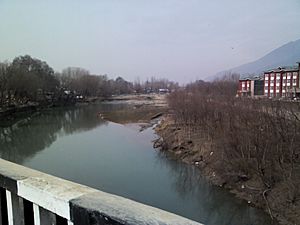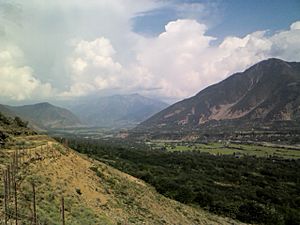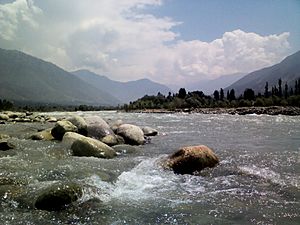Sind River facts for kids
Quick facts for kids Sind River |
|
|---|---|

Sind River
|
|
| Country | India |
| Union territory | Jammu and Kashmir |
| Region | Kashmir Valley |
| District | Ganderbal |
| Physical characteristics | |
| Main source | 34°12′14.860″N 75°35′21.94″E / 34.20412778°N 75.5894278°E Machoi Glacier 4,800 m (15,700 ft) |
| River mouth | 34°11′2.382″N 74°40′36.21″E / 34.18399500°N 74.6767250°E Jhelum river at Shadipora 1,600 m (5,200 ft) |
| Length | 108 km (67 mi) |
| Depth |
|
The Sind River is an important river in the Ganderbal district of Jammu and Kashmir, India. It is a main branch, or tributary, of the Jhelum River. The Sind River flows for about 108 kilometres (67 miles).
Contents
Journey of the Sind River
The Sind River creates the lovely Sind Valley. This river begins high up in the Machoi Glacier. This glacier is about 4,800 meters (15,700 feet) above sea level. It is located east of the Amarnath temple and south of the Zoji La pass.
The river first flows south through a camping area called Panjtarni. Then, at a place called Domail, another stream joins it. This new stream comes from the Kolhoi Glacier and makes the Sind River's flow much stronger. After this, the river mostly flows west. It follows along the main road, NH 1D. Many small streams from glaciers add water to the Sind River as it flows towards Ganderbal town.
River Branches and Water Use
At Kichpora Preng, the Wangath river joins the Sind. The Wangath river flows down from the Gangabal Lake. Other important streams that feed the Sind River include the Amarnath stream, Kolhoi Grar, Shitkadi Nallah, Gund Nallah, and Surfraw Nallah. Surfraw Nallah is a large stream known for its beauty and fish.
The Sind River becomes calmer and wider near Ganderbal town. From here, boats can travel on it. The river eventually meets the Jhelum River at Shadipora. This spot is about 17 kilometres (11 miles) northwest of Srinagar. The Sind River also flows through Sonamarg, a popular mountain resort. Here, exciting river rafting events are held every year.
The Sind River is special because it has three hydroelectric power plants. These plants use the river's water to create electricity. The river's water is also used for irrigation to help crops grow. After being cleaned at water treatment plants, the water is also used by people in their homes.
Amazing River Life
The Sind River is home to many types of fish. It is especially famous for its trout.
Fish Species in the Sind River
Some of the most well-known fish found here are:
- Brown trout (Salmo trutta)
- Rainbow trout (Oncorynchus mykiss)
- Snow trout (Schizothorax plagiostomus)
- Shuddgurn
- Anyour
Protecting River Life
It is important to protect the fish in the Sind River. There are a few things that can harm the fish and their homes:
- When heavy machines dig up sand and gravel from the river, it can destroy the places where fish live and lay eggs.
- Waste from homes and camps near the river can pollute the water.
- Using chemicals like pesticides and insecticides by farmers can also harm fish.
- Changes to the river's shape can hurt the animals living in the water.
- Some people use harmful methods to catch fish, like using bleaching powder. This chemical kills not only fish but also other river creatures. This is a big problem, especially in summer.
It is important for everyone to help keep the river clean and safe for all its creatures. Government groups are working to manage the river's water and protect its fish.
Big Projects on the Sind River
The Sind River is important for several large projects:
- Upper Sind Hydroelectric Power Project 1st at Sumbal.
- Upper Sind Hydroelectric Power Project 2nd at Kangan.
- Lower Sind Hydroelectric Power Project at Ganderbal.
- Rangil water treatment plant, which cleans water for people to use.
Important Bridges
Two major bridges cross the Sind River:
- Wayil Road Bridge of NH 1D. This is a steel bridge that allows one-way traffic at a time.
- Duderhama Road Bridge, which connects to Ganderbal town.





